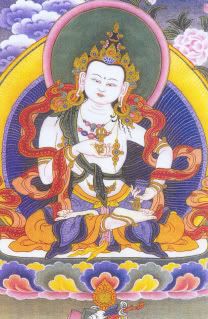Tibetan: dor je sem pa.
English: the Vajra Hero.
Vajrasattva means "diamond being" or "vajra-being". Its character is as strong as a vajra. By practicing his Dharma, the follower can avoid all evil thoughts, eliminate vexations and have unlimited happiness and wisdom. Meanwhile the guardian deities will forgive them for any mistakes they have made in practicing Buddhism and bestow them a fortune that makes up for any loss. Vajrasattvathe dhyani-boddhisattva or spiritual son of dhyani-buddha, Akshobhya is also regarded as chief of the five dhyani-buddhas. He is usually represented seated on a lotus posture. He wears a crown in which there is often an image of Akshobhya, and the dress and ornaments of Dhyani-Buddhisattva. Against his breast, he generally holds vajra in his right hand; but the vajra may be balanced on its point in the palm of his hand. With the left, he holds the ghanta on his hip. If standing, he balances the vajra in his right hand against his breast, while in the left, hanging pendent, he presses the ghanta against leg. Unlike the other Dhyan-Boddhas, he is always crowned with or without his sakti whom he presses against his breast in the yab-yum attitude, with the right hand holding vajra, while the left holds the ghanta on his hip.
http://discussions-neighborhoods.ebay.com/topic/Antiques-Antiquing-Discussions/Vajrasattva/1300087401




No comments:
Post a Comment